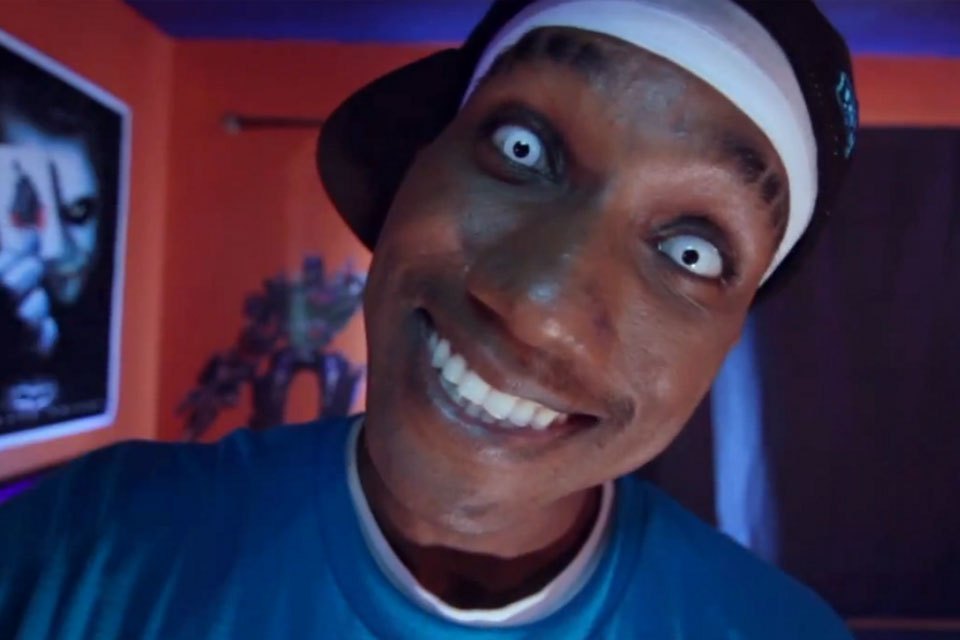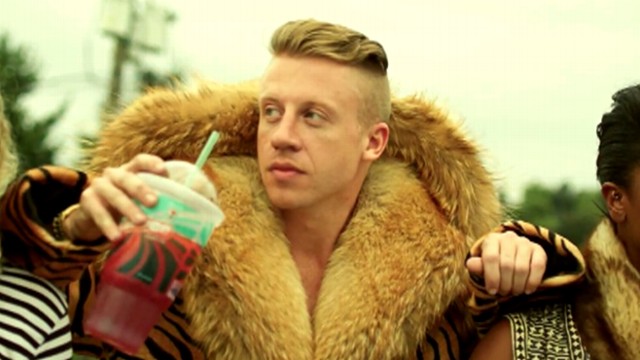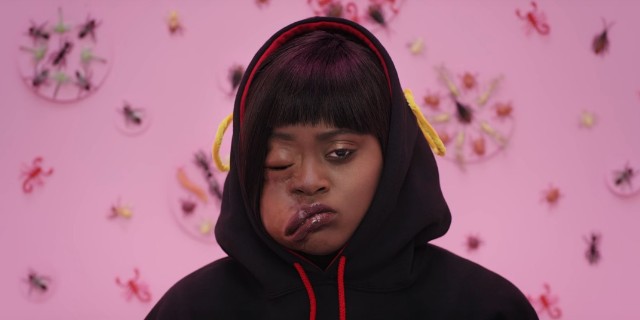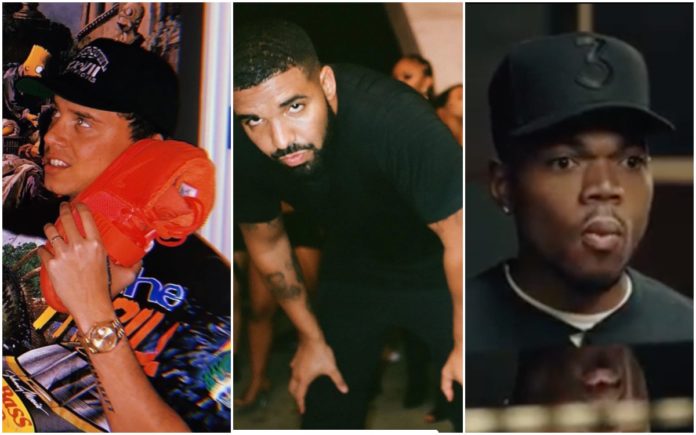Make sure to check out HipHopMadness‘ video on the subject. The following is a lightly-edited version of the video’s script, so forgive me for swapping my typically conversational tone for a more removed, informative one.
ALSO: My personal opinions on which rappers are/aren’t corny are not reflected in this piece. The rappers used as examples in this piece are referenced due to popularity. Recognizable faces and discographies make it easier for anyone reading to understand how the term “corny” is/should be used in hip-hop.
-Zander
Corny, |corn-y|, [adj]: trite, banal, or mawkishly sentimental. Basically, cliché, empty, or fake deep.
In a hip-hop context, this is not far off from how many fans and critics use the word “corny” to criticize artists. It’s used to call out artists who are either dishonest in their lyrics, fake in their image, empty in their value despite their ability, or some combination of these factors. In other words, the things about rappers that make listeners cringe.
While it doesn’t always harm a rapper’s ability to sell records, the “corny” label can severely limit the respect an artist gets outside of their fan base. With artists like Macklemore, Logic, Hopsin, and even J. Cole at times being hit with this label, we have to understand what corniness is and why it is such an important term in hip-hop.
How not to be corny
At its core, hip-hop culture is a platform for unheard voices and stories from the margins of society to be heard in their truest form. From the innovative, unruly New York artists that started it all in the 1970s and 80s all the way to today’s sing-rap crooners, hip-hop zeitgeists tend to speak against mainstream culture. As part of this speaking out, artists typically either tell their stories, like NWA describing police brutality, or push back against common stories, like Kanye challenging gangsta rap and Black hypermasculinity. Many of rap’s biggest acts—including Ye, Jay-Z, and Pac among others—have done both.
For example, despite facing his own allegations of corniness, Drake has introduced Toronto culture and heightened sentimentality to hip-hop and popularized the seamless mesh of singing and rapping to go along with his criticism of peers who are afraid to be vulnerable in their music or don’t take music as seriously as he does.
However an artist uses their voice, authenticity and uniqueness are essential qualities in legendary hip-hop acts. When the technical ability of two artists is comparable, the difference between one being widely respected and the other being “corny” is in the originality and realness of each artist.
Artists that bring something new to the table, whether it’s a sound, flow, persona, or subject matter, can be celebrated despite flaws in musical ability. Artists with great or even exceptional ability that bring nothing new to the game, or use their platform to criticize more than they add to the game, are often labeled as corny.
How critiques/disses can be corny

A great example of a talented artist who’s reputation has suffered from the “corny” label is Hopsin. Hailing from L.A., Hopsin had a very promising start to his career, being signed to Ruthless Records in 2007 and forming his own record label Funk Volume in 2009. In late 2010, he released his first viral hit “Sag My Pants,” an ode to his delinquency and skateboarding background. In the song, he pokes fun at many of the year’s hottest mainstream rappers including Soulja Boy, Drake, Lil Wayne, and Lupe Fiasco.
While the song demonstrated Hopsin’s obvious gift for rapping and witty takes on hip-hop culture at the time, people lost interest in the act very quickly.
In 2011, he dropped the first of his 8-song series “Ill Mind of Hopsin” in which he dissed Tyler, The Creator and Odd Future for making what he thought was random and negative content. Tyler responded saying he thought Hopsin was talented, but leaning too hard on dissing Tyler for attention. Hopsin got a similar response from Soulja Boy later that year where he said Hopsin was dope, but not worth responding to until he was more famous. While Soulja Boy did respond with a diss track in 2012, the beef was no longer relevant.
Essentially, Hopsin’s most memorable moments in his first years of fame were spent using his exceptional rapping ability to mock and criticize the most famous rappers of the time instead of telling his own story. Since he was never responded to, it never amounted to more clout.
In an interview with District Magazine in 2018, Hopsin expressed disappointment in being pigeonholed as a corny rapper, saying that he wishes he could “make normal songs” without being slept on. To many rap fans, and by Hopsin’s own admission in the interview, Hopsin put himself in that hole by spending much of his time in the limelight criticizing rather than adding to the game.
Hopsin still became a millionaire as an independent artist, but it’s clear he would have been more celebrated if he spent less time self-righteously preaching.
With hip-hop becoming increasingly mainstream in the 2000s, Hopsin certainly was not the last artist to use their platform to critique rap trends. A slew of artists in the past decade or so, including Joyner Lucas and late-career Eminem, have used their art to critique the culture’s more controversial trends, including mumble rap and drug culture. While both artists have enjoyed considerably more commercial success than Hopsin, many listeners have written off their critiques of the game as bitter and preachy rather than inspiring or tasteful.
How personas can be corny

Rather than being called corny for criticizing the game, some of today’s most popular positivity rappers such as Macklemore and Chance The Rapper are called corny for just that, being very positive. To a fan, the artists are thorough in their messages and are an example of hip-hop’s power to spread love. To a critic, Macklemore and Chance are cashing in on a family-friendly image not many rappers can successfully pull off.
While the musical résumés of each artist speak for themselves, successes such as Macklemore’s Best Rap Album win at the 2014 GRAMMYs and Chance’s pivot from the vivid, unfiltered Acid Rap to the heavily gospel-influenced Coloring Book have made some fans look at these artists’ images with skepticism.
Some artists are deemed corny for appearing hollow and negative, others for appearing hollow and positive. Then there are mega-famous rappers who are simply so big, they’d have to drop bonafide classic albums every time around to avoid corniness accusations. This is the kind of criticism rappers such as J. Cole, Drake, and Big Sean face given their huge mainstream success.
With Cole, it’s a lighter version of the criticism Joyner Lucas faces where instead of being seen by fans as a complete hater, he’s the young uncle who’s not as cool as he thinks. Some fans are quick to point out that Cole has many mediocre misogynistic bars that people ignore because of his conscious image, with “No Role Modelz” being a go-to example. Drake also faces this criticism throughout his discography, with “Hotline Bling” being the most popular example.
Along with views of them as not-so-good good guys, Cole and Drake are both known for the occasionally mid or simply trash bars, which wouldn’t be a huge deal if they weren’t GOAT contenders.
Cole lines like, “I let you feel like you the shit, but you can’t out-fart me,” (“Dollar and a Dream III,” Sideline Story) and Drake lines like, “Keychain go jangalang, I wanna do major thangs,” (“9,” Views) are examples of what fans would point to as evidence in “Cole/Drake is corny” arguments. And whereas Cole and Drake are roasted from the sidelines on forum sites such as KanyeToThe and Genius, major publications such as Complex and much of hip-hop Twitter have field days whenever Big Sean releases a project because he’s widely viewed as having some of the laziest bars in the game.
Corniness accusations against Drake also stem from his recent genre and culture-hopping, which continues to toe the line between appreciation and appropriation (something I’ve touched on). While he’s forced Toronto’s deep multiculturalism into public knowledge, he’s also noticeably picked up the use of UK roadman talk and Jamaican patois in social media posts and his music the last several years. Whether a fan finds this corny or not depends on if they believe it’s genuine or not.
Why more mainstream rappers aren’t considered corny
The unfortunate part about the corniness debate is that it only involves the most successful rappers. This discussion focuses so much on today’s leaders of the pack, it’s easy to overlook the herd. For example, despite the oversaturation of bubblegum trap artists and mid-level sing-rap crooners, many run-of-the-mill mainstream rappers do not get hit with the “corny” label as much as their more lyrical or conscious peers. This is mainly because their personas and messages are not as ambitious or deviant.
Artists of the sort (i.e. the majority of the game) are less unique and controversial, meaning they’re easier to accept. This allows them to duck serious criticism of their authenticity more easily. But under the same microscopes that we place big-name artists such as Drake, Logic, J. Cole, and Joyner Lucas, it’s no secret many rappers of lesser status would have similar or even greater flaws in their personas and bars.
Rappers who aren’t viewed as corny

With so many of our favorite rappers being viewed as corny one way or another, which artists can we view as models of non-corniness?
Many neutral fans would point to Kendrick Lamar as an example of an artist who isn’t corny. As a rapper who tackles major sociocultural issues, Kendrick has very little room for error. But not only has his sound evolved and challenged listeners with each album, it’s widely agreed that he’s given us valuable critique of the rap game and the state of the world while maintaining humility and a high level of original rapping.
The political, funk-influenced album To Pimp a Butterfly was a masterpiece and a departure from his storytelling classic GKMC. And when he made albums with more commercial appeal like the Black Panther soundtrack and DAMN, he managed to hold onto his conscious West Coast roots while making songs that everyone can enjoy, such as “King’s Dead” and “Humble.”
Along with Kendrick, a long list of the greatest street and trap rappers in recent memory including the Griselda roster, Freddie Gibbs, YG, and Gucci Mane easily avoid the “corny” label because their discographies are firmly rooted in their experiences and their voices/personas are one of a kind. Pioneers of sounds and flows such as E-40 and Too Short with the Bay Area sound, or Rakim, Big Daddy Kane and Slick Rick as pinnacles of inventive flows in the late 80s/early 90s are also artists never thought of as corny.
Many of today’s hottest women rappers are also widely viewed as refreshing. The skill level of rappers such as Noname, Tierra Whack, Rico Nasty, Megan Thee Stallion, and Rapsody lay a foundation of respect for their boundary-pushing content and styles to challenge what top male artists have been offering the past several years. With a variety of unique sounds and new, confident takes on topics like sexuality, identity, and the come-up, this wave of heavy-hitting women sets a new standard in originality.
As there are levels to artistic influence, there are levels to corniness. Some artists are seen as uninspired wave-riders who jumped on trendy sounds once they hit their creative peaks. Other artists are deemed artistically corny from the start. Some artists are only corny in their persona or opinions on a certain topic, while other artists display unoriginal and cynical critiques of society and the rap game in a number of areas.
If anything, this discussion proves that it is very difficult for a hip-hop artist to remain 100% refreshing and unique throughout their career. At some point, the vast majority of rappers do something or have a period in their career that can be considered corny by the masses. If not, it’s a huge accomplishment. But if so, your favorite rapper being labeled “corny” is not always a full-on attack on their ability, worthiness, or significance to the culture.
UPDATE 2/10/2021: Edited for brevity and list of non-corny rap veterans. Cue the JPEG album.
UPDATE 4/20/2021: Edited for structure.

damn this is a really well written piece. nice work
Hope you still active bro
Oh we active, don’t een trip.
-Zander